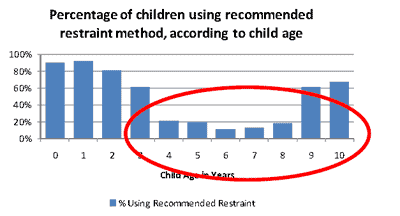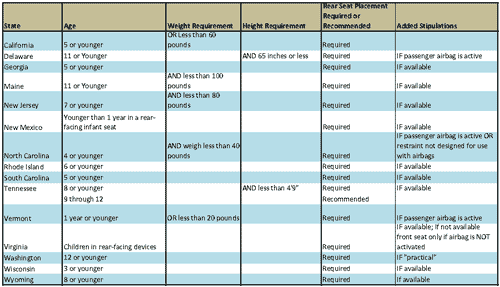MPC
Research Projects (2009-10)
Identifying Number
MPC-334
Project Title
Proper Seat Placement of Children Aged 4 to 12 within Vehicles
University
North Dakota State UniversityProject Investigator
Andrea Huseth
Description of Project Abstract
Traffic safety is a widespread social concern. However, for the more vulnerable populations in our society, children and youth, it is even more of a concern. There are numerous programs available for infants and toddlers in regards to proper placement and proper restraining systems within vehicles (local car seat clinics, pediatricians) and new drivers also have programming available to them (i.e. driver's education). However, the gap in 'proactive' education appears to encompass those children aged 4-12. This group appears to have fallen through the cracks in terms of occupant safety. This age group has been dubbed "the forgotten child" in some research circles (Javouhey et al, 2006).

Source: Ebel et al, 2003
Between 2000 and 2005 (2005 is the most recent year for leading causes of death), motor vehicle crashes were the number one cause of death of children aged 4 to 12 in North Dakota (WISQARS). Between 2000 and 2005 half of the deaths among North Dakota's youth ages 4 to 12 were caused by unintentional injury. Motor vehicle deaths accounted for 42 percent of those unintentional injuries. Of the 56 children between the ages of 4 and 12 killed in motor vehicle crashes between 2003 and 2007 (2007 is the most recent year available for motor vehicle fatalities), 15 or approximately 27 percent were front-seated (FARS). It is possible that some of these deaths would have been prevented by placing the children in the back seat of the vehicle. The ND Department of Health, Injury Prevention Program conducts biannual child restraint observation surveys throughout the state of North Dakota. According to a recent report released by the Injury Prevention Program (2007), in 2006, approximately 19.2% of children aged 10 or younger were seated in the front seat of the vehicle in which they were riding. It should be noted that only the ten most populous cities in North Dakota were surveyed, and that front seating may be more common in rural areas than urban areas. Also, a study by Glass and Graham (1999), examined where children (dead or surviving) were sitting in passenger vehicles when fatal crashes occurred in the United States during 1985-1996. In that study, in North Dakota, overall, 37.4 percent of children involved in fatal crashes were seated in the front seat. However, when only those crashes where children were traveling alone or with other children under the age of 12 were observed, the percent of children aged 12 or younger sitting in the front seat jumps to 85 percent.
According to Braver et al (1998) children aged 12 years or younger who were seated in the back seat were 36% less likely to die as a result of a motor vehicle crash compared with front-seated children. A more recent study by Durbin et al (2005) found that children were 40% safer when seated in the back of a vehicle than in the front when involved in a crash, and the risk of injury declined to less than 2% when rear-seated children were secured in age-appropriate restraint systems. In 1997, the National Transportation Safety Board recommended that each state amend its child passenger safety laws to make child rear seating required (Greenberg-Seth et al, 2004). To date, fifteen states have passed legislation mandating child rear seating (http://www.iihs.org/). However, only one of those states requires children as old as 12 to sit in the back seat of a vehicle, 'if practical', and one 'recommends' that children aged 9-12 sit in the back seat of a vehicle, but it's not mandatory. Neither North Dakota nor any of the surrounding states (Minnesota, South Dakota, Montana, Wyoming, or Colorado) have any legislation requiring or recommending child seat placement within a vehicle.
Child Restraint Laws Concerning Seat Placement Within Vehicles as of March 2009 (www.iihs.org)

If research states that children are safer when rear-seated in a vehicle, that they are less likely to suffer severe injuries and are much less likely to suffer fatal injuries, why would parents still make the choice to allow their children to sit in the front seat of a vehicle? This is precisely what this research project hopes to determine. While placement in the front seat of a child or youth is not against the law in North Dakota, one can only hope that placement in the front seat of a child or youth by an adult is done in ignorance of the encouraged proper seat placement in the back seat of a vehicle.
Understanding parental perceptions of the risks associated with having children sit in the front seat of a vehicle can provide insight to designing interventions to reduce that risk (Will and Geller, 2004).
Project Objectives
The goals of this project are to raise awareness of safe placement for children within a vehicle and to assess the need for additional parental/guardian education regarding child placement within a vehicle. It is hoped that as a result of this project, there would be a decline in traffic deaths and injuries for children between the ages of 4 and 12. In addition, urban/rural differences in child occupant safety behaviors and traffic safety perceptions will be tested.
How will this be accomplished?
- By evaluating current child placement within vehicles (availability of seats in the back of a vehicle if the child is placed in front, assessing only vehicles in which one adult is present).
- By evaluating parents' perceptions and knowledge of safest placement of children in vehicles.
- By evaluating factors that affect parents' decisions about where their children should be placed within a vehicle.
Project Approach/Methods
A combination of survey and focus group research methods will be used to gather information on practice and perceptions. Current child placement within vehicles will be ascertained through observation surveys. Observation surveys will be done inside the Fargo-Moorhead metropolitan area and within rural areas as well. The UGPTI will invite elementary and middle schools, with the possibility of partnering additionally with daycares, to participate in observational seating surveys at their facilities. Only those vehicles which have no adult passengers in the front seat will be surveyed, as the presence of adult passengers has been shown to greatly reduce the odds of child front seating (Segui-Gomez et al, 1998). The survey form will be designed to collect information such as:
- Are children within the vehicle front-seated or rear-seated?
- If front-seated, is room available in the rear of the vehicle for the child to be rear-seated?
- Is the child properly restrained? (i.e. booster seat, lap/shoulder belt)
- Is the driver properly restrained?
Focus groups will be conducted with parents who have at least one child between the ages of 4 and 12. Two groups will be conducted with parents living within the Fargo-Moorhead area, and two groups will be conducted with parents living outside of the Fargo-Moorhead area. For each of the two areas, one focus group will be conducted with parents who have been observed to seat their children in the front seat of their vehicle and another will be conducted with parents chosen randomly from the population. The group discussion will be designed to gather information regarding parents' perceptions and knowledge of safe placement for child in vehicles. In addition, parents will be asked to discuss factors and their relative influence in parents' decisions about where their children should ride in a vehicle. The hypothesis that there is a difference between parental attitudes of child occupant safety of urban parents versus rural parents will be tested as well. Parents will also be queried regarding their receptiveness of child safety information based on sponsor, source, content, and delivery media.
Tasks:
- Background/prep work.
- Conduct direct observation surveys of local schools and daycare centers.
- Conduct parent focus groups.
- Analyze data/information gathered.
- Create summary reports for various audiences.
MPC Critical Issue(s) Addressed by the Research
- Human factors
Contributions/Potential Applications of Research
Observation surveys will provide a baseline to needed to better understand crash risk exposure for young passengers. Anecdotal information on parental knowledge and factors that affect their decisions about where children should ride as the passenger in a vehicle will be valuable in more effectively using scarce resources to promote traffic safety. Ultimately, this information will add to the body of knowledge regarding child occupant protection, increase the understanding of barriers to proper child occupant protection, and will reduce traffic fatalities of children between the ages of 4 and 12.
Technology Transfer Activities
A research report providing a summary of findings which can be used by traffic safety organizations, such as the ND Department of Health, ND Department of Transportation, and Safe Kids of Fargo-Moorhead, to help develop and expand current programming beyond occupant safety for younger children and young drivers. The research will also be presented to local audiences and submitted for research conference presentation and journal publication.
Time Duration
July 1, 2009 through June 30, 2010
Total Project Cost
$11,736.00
MPC Funds Requested
$5,868.00
TRB Keywords
Traffic safety, child passenger safety, behaviors, occupant protection
References
- Durbin, DR, R Chen, R Smith, MR Elliott, and FK Winston. 2005. Effects of seating position and appropriate restraint use on the risk of injury to children in motor vehicle crashes. Pediatrics 115: e305-e309.
- Ebel, BE, TD Koepsell, EE Bennet, and FP Rivara. 2003. Too small for a seat belt: Predictors of booster seat use by child passengers. Pediatrics 111: e323-e327.
- Ferguson, SA, JK Wells, and AF Williams. 2000. Child seating position and restraint use in three states. Injury Prevention 6: 24-28.
- Glass, RJ, and JD Graham. 1999. Kids at risk: Where American children sit in passenger vehicles. Journal of Safety Research 30(1): 17-24.
- Greenberg-Seth, J, D Hemenway, S Gallagher, JB Ross, and KS Lissy. 2004. Evaluation of a community-based intervention to promote rear seating for children. 94 (6). American Journal of Public Health: 94(6): 1009-1013.
- Insurance Institute for Highway Safety. Child Restraint Laws. http://www.iihs.org/laws/ChildRestraint.aspx
- Javouhey, E, A-C Geurin, B Gadegbeku, M Chiron, and D Floret. 2006. Are restrained children under 15 years of age in cars as effectively protected as adults? Archives of Disease in Childhood 91: 304-208.
- Lennon, Alexia J. 2007. A risky "treat": exploring parental perceptions of the barriers to seating their children in the rear seats of passenger vehicles. Injury Prevention 12(2): 105-109.
- North Dakota Department of Health, Injury Prevention Program. 2007. How North Dakota Kids Ride: Child Passenger Safety Observation Report.
- Segui-Gomez, M., RJ Glass, and JD Graham. 1998. Where children sit in motor vehicles: A comparison of selected European and American cities. Injury Prevention 4: 98-102.
- Will, KE and ES Geller. 2004. Increasing the safety of children's vehicle travel: From effective risk communications to behavior change. Journal of Safety Research 35: 263-274.

